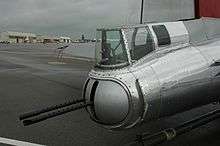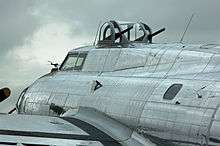Yankee Lady
The B-17 Yankee Lady is owned by the Yankee Air Force, doing business as the Yankee Air Museum (YAM), and was flown for flight experience rides and airshow appearances.
| Yankee Lady | |
|---|---|
 | |
| Type | Boeing B-17G–110–VE Flying Fortress |
| Manufacturer | Vega Aircraft Corporation |
| Registration | N3193G |
| Serial | 44-85829 |
| Owners and operators | Yankee Air Force |
| Preserved at | Yankee Lady is owned by the Yankee Air Force, doing business as the Yankee Air Museum (YAM). |
Provenance
Yankee Lady is a B-17G–110–VE, bearing USAAF serial number 44-85829. The airplane was built by the Vega Division of Lockheed Aircraft Corporation at Burbank, California and was delivered to the USAAF on July 16, 1945. It went to Dallas, Texas for modifications and in September 1945 was placed in storage at South Plains Field, Texas along with other brand new B-17s. The YAM is certain that this aircraft did not fly combat missions during World War II.
In 1946 the aircraft was one of 16 “Flying Fortresses” that were transferred to the U.S. Coast Guard. These aircraft were re-designated PB-1Gs, “P” signifying patrol, “B” denoting designed by Boeing, “1” for the first model of the type and “G” for Coast Guard. This particular aircraft then became PB-1G serial number 77255. All of the guns and turrets were removed, and a radar dome was installed in the position formerly occupied by the chin turret. It was used for air-sea rescue and iceberg patrol duties out of Naval Station Argentia, Newfoundland, Elizabeth North Carolina and San Francisco, California. At one time it carried an air droppable, 27 foot long 3300 pound wooden lifeboat under the fuselage for rescuing people stranded at sea. This aircraft was retired from the U.S. Coast Guard in 1958.
On May 11, 1959, the airplane was sold to Ace Smelting, Inc. for $5997.93. It was assigned the civil registration N3193G. In November 1959 Fairchild Aerial Survey Company purchased the aircraft and used it for aerial survey work. In 1966 the plane was sold to Aircraft Specialties, Inc. of Mesa, Arizona. This company used numerous B-17s as air tankers to fight forest fires and apply pesticides on crops and trees. During 1969 the aircraft was one of five B-17s flown to Hawaii and used in the filming of the 1970 film Tora! Tora! Tora!
In 1985 the airplane was among four other B-17s that were put up for sale at an auction held by Globe Air, the successor company to Aircraft Specialties. The airplane remained unsold until the Yankee Air Force purchased it for $250,000 in June 1986. After several test hops, the aircraft was flown from Mesa, Arizona to Willow Run Airport, Ypsilanti, Michigan on July 2, 1986. It was not to fly again for nine years.
The rebuild history


A comprehensive inspection and repair/rebuild program was initiated almost immediately after the B-17 arrived at the YAM. The primary goal was to return the aircraft to safe flying condition, with the secondary objective of reinstall as much authentic combat equipment as was obtainable and practical.
Upon close examination, it was found that the plane was quite literally only a shadow of a World War II combat-configured B-17. All turrets and guns were missing. Floors had been lowered and bulkheads removed during its long and varied postwar career. A large cargo door had been installed in the left side of the fuselage.
The vertical and horizontal tail surfaces were removed in order to repair areas of corrosion. All control surfaces were recovered using modern fabric, and the control cables inspected and replaced as necessary. The floor in the radio room raised to its original position and authentic radios installed along with a table for the radio operator.
The two 1000 gallon fire retardant tanks were removed, and the bomb bay doors re-installed along with the equipment required to be able to open and close them in flight. Bomb racks were built from scratch. The roof above the bomb bay was removed to repair the structure that had been modified when the chemical tanks were fitted.
The outer wing panels were removed to allow replacement of the aileron attachment channels, which were corroded. The long-range Tokyo auxiliary fuel tanks were removed. All four Wright R-1820-97 nine cylinder turbocharged radial engines were dismounted and the two outboards overhauled at a cost of over $25,000 a piece. Every hose and electrical wire in the airplane has been replaced.
A Sperry ball turret and a Bendix chin turret were acquired, renovated and re-installed in the aircraft. A top turret dome has been fitted along with cheek guns in the nose compartment. A replacement Cheyenne tail turret was obtained and restored to its World War II configuration.
The aircraft has been painted in the markings of a typical B-17G assigned to the 534th Bombardment Squadron ("GD"), 381st Bombardment Group (Triangle L), 8th Air Force flying out of RAF Ridgewell in England in late 1944. This color scheme is a memorial to the late Joseph Slavik who flew 35 missions as a pilot with the 381st. Mr. Slavik and his brother Stephen made a significant financial contribution to the Yankee Air Force that helped purchase the plane.
The “Yankee Lady” name and nose art do not replicate that of a known combat veteran B-17, but rather are meant to be representative of the era.
The restoration work was accomplished almost entirely by dedicated Yankee Air Force volunteers who generously donated time, talents, and financial resources to what has truly been a labor of love. The first post-restoration flight took place on July 13, 1995.
Yankee Lady offers flight experience rides from the middle of May through September for the crew of 3 and an additional 12 people. Proceeds help support the Yankee Lady and the Yankee Air Museum.
Notable events
In 2018, Yankee Lady and another operational B-17, the Aluminum Overcast, were onhand with re-enactors for the debut of the famous Memphis Belle bomber at the National Museum of the U.S. Air Force.[1]
Bibliography
YAM handout for flight experience.
References
- Barrie Barber, Staff Writer. "Two-B-17s will soar over Dayton as part of Memphis Belle debut". daytondailynews.